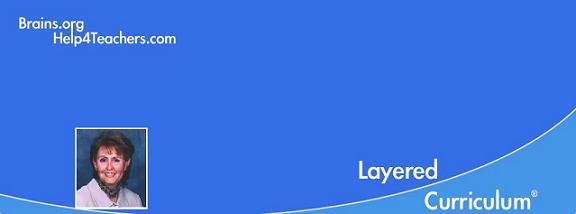__________Layered Curriculum®. . . because every child deserves a special education™_
 |
|
![]() _
_ ![]()
Layered
Curriculum TEXT & WORKBOOK
Set
for only
$43.95
(free shipping in
US)
Tweet
The Advantages of BilingualismBy Dr. Kathie F. Nunley
Many of our students may be unaware that they bring with them, one of the strongest cognitive advantages to learning. They are fortunate enough to be bilingual. The ability to speak more than one language is one that offers many cognitive rewards now and into old age.
People who speak more than one language fluently throughout their life have better problem solving skills, better attention, improved executive function and reduce the risk and severity of Alzheimer's, dementia, and other brain deterioration issues.(Bialystok, 2004, 2010) Children who are bilingual may have some benefit in learning to read due to a stronger working memory. (Swanson, 2006)
Speaking more than one language is more complex than we first thought. Bilingualism requires a fundamental reorganization of the entire language system in the brain. Having more than one language housed in the brain puts tremendous pressure on the prefrontal cortex, that area of our brain that deals with working memory and executive function. For this reason, brains of persons who are bilingual have a constant mental workout in this particular brain region, (Penn, 2010). The result is no different than what happens when you work out any area of the body - strength and increased efficiency.
The reasons for this appear to be multiple. First, if you are fluently bilingual, the areas of the brain that operate both languages are operating all the time. This is true, even if you remain in a mono-linguistic environment. For example, if you speak both Portuguese and English fluently, but work in an English speaking school and live in an English speaking community so that all day long you hear and speak nothing but English, the area of your brain responsible for Portuguese is still running as you speak and listen to English. Both areas run in tandem.
The areas of dual language are very much intertwined and organized by the brain region responsible for executive function. Apparently the lexicons of the languages are partially shared and handled by the prefrontal cortex. We can see this in instances of aphasia. Aphasia is a condition where language, or parts of language are lost, usually due to a head trauma. Occasionally the aphasia results in a very select deficit in just one area of lexical processing. For example, a person may lose the ability to speak nouns or just verbs, or even just past tenses of verbs. When this type of injury happens to a bilingual person, they lose the specific grammatical class in both languages. In other words, if you speak both French and English and can no longer say any nouns, you have lost that ability in both languages. (Mozzo, 2010) I'll mention here too, that recovery is faster and more complete for this condition if you are bilingual. (Penn, 2010)
New research is also showing us how critical language is to the formation of cultural self. A person's cultural belief system and autobiographical recounts are influenced and accessed differently through different language. Bilingual children who were interviewed in both of their languages had different stories, memories and personal reports based on which language was used in asking the question. (Wang, 2010)
So, what does this mean for bilingual students in our classrooms? Help them understand this incredibly valuable gift they bring with them to school. Encourage them to continue to use, speak and read, whenever possible, in both of their languages. Ask them questions that they can respond to in either language. Have them share stories, recall information and learn in both languages: "Tell me in English what you remember learning about the water cycle, and then tell me again in Luganda." Encourage their bilingualism. Help them celebrate their gift.
Citations
Bialystok, Ellen. (2010). Global-local and trail-making tasks by monolingual and bilingual children: Beyond inhibition. Developmental Psychology, Vol 46(1), 93-105.
Bialystok, E.; Craik, F.; Klein, R. & Viswanathan, M. (2004). Bilingualism, Aging and Cognitive Control. Psychology and Aging, Vol 19(2), 290-303
Miozzo, M.; Costa, A.; Hernández, M; Rapp, B. (2010). Lexical processing in the bilingual brain: Evidence from grammatical/morphological deficits. Aphasiology, Vol 24(2), 262-287
Penn, C.; Frankel, T.; Watermeyer, J.; Russell, N. (2010). Executive function and conversational strategies in bilingual aphasia. Aphasiology, Vol 24(2), 288-308
Swanson, H., Saez, L. & Gerber, M. (2006). Growth in Literacy and Cognition in Bilingual Children at Risk or Not at Risk for Reading Disabilities. Journal of Educational Psychology, Vol. 98(2), 247-264.
Wang, Qi; Shao, Yi; Li, Yexin Jessica (2010). "My way or mom's way?" The bilingual and bicultural self in Hong Kong Chinese children and adolescents. Child Development, Vol 81(2), 555-567.
About the Author:
Dr Kathie Nunley is an educational psychologist, researcher and author of several books on parenting and teaching, including A Student's Brain (Brains.org) and the best selling, "Differentiating the High School Classroom" (Corwin Press). She is the developer of the Layered Curriculum® method of instruction and has worked with parents and educators around the world to better structure schools to make brain-friendly environments. In addition, her work has been used by the Boeing Corporation, Family Circle Magazine, the Washington Post, and ABC television.
Email her: Kathie (at) brains.orgCopyright © 1998 - current year by Kathie F. Nunley.
All Rights Reserved.
Layered
Curriculum is a registered trademark developed by
Dr. Kathie F. Nunley.